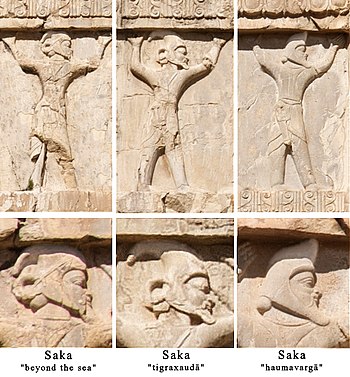𐎿𐎣
Jump to navigation
Jump to search
Old Persian[edit]

Etymology[edit]
From Scythian, see Ancient Greek Σκύθης (Skúthēs) for more.
Proper noun[edit]
𐎿𐎣 (Saka)
- Scythia, an ancient region of the eastern Iranian Plateau.
- Saka and Scythians, a nomadic people of the Eurasian steppes
-
- 𐏐 𐎴𐎮𐎡𐎫𐎲𐎡𐎼𐎶 𐏐 𐎠𐎭𐎶 𐏐 𐎲𐎠𐎲𐎡𐎼𐎢𐎺 𐏐 𐎠𐎺𐎠𐎩𐎴𐎶 𐏐 𐎰𐎠𐎫𐎡𐎹 𐏐 𐎭𐎠𐎼𐎹𐎺𐎢𐏁 𐏐 𐎧𐏁𐎠𐎹𐎰𐎡𐎹
𐏐 𐎹𐎠𐎫𐎠 𐏐 𐎠𐎭𐎶 𐏐 𐎲𐎠𐎲𐎡𐎼𐎢𐎺 𐏐 𐎠𐏃𐎶 𐏐 𐎡𐎶𐎠 𐏐 𐎭𐏃𐎹𐎠𐎺 𐏐 𐎫𐎹𐎠 𐏐 𐏃𐎨𐎠𐎶 𐏐 𐏃𐎷𐎡𐏂𐎡𐎹𐎠
𐏐 𐎠𐎲𐎺 𐏐 𐎱𐎠𐎼𐎿 𐏐 𐎢𐎺𐎩 𐏐 𐎶𐎠𐎭 𐏐 𐎠𐎰𐎢𐎼𐎠 𐏐 𐎸𐎢𐎭𐎼𐎠𐎹 𐏐 𐎱𐎼𐎰𐎺 𐏐 𐎶𐎼𐎦𐎢𐏁 𐏐 𐎰𐎫𐎦𐎢𐏁
𐏐 𐎿𐎣 𐏐 𐎰𐎠𐎫𐎡𐎹 𐏐 𐎭𐎠𐎼𐎹𐎺𐎢𐏁 𐏐 𐎧𐏁𐎠𐎹𐎰𐎡𐎹 𐏐 𐏑 𐎶𐎼𐎫𐎡𐎹 𐏐 𐎶𐎼𐎫𐎡𐎹 𐏐 𐎴𐎠𐎶
𐏐 𐎨𐎡𐎨𐎧𐎼𐎠𐎡𐏁 𐏐 𐎱𐎢𐏂 𐏐 𐎤𐎢𐎥𐎴𐎣𐎠 𐏐 𐎴𐎠𐎶 𐏐 𐎺𐎼𐎭𐎴𐎶 𐏐 𐎱𐎠𐎼𐎿𐎡𐎹 𐏐 𐎠𐎺𐎭𐎠 𐏐 𐎠𐎭𐎠𐎼𐎹 𐏐- : n-di-i-t-b-i-r-m : a-d-m : b-a-b-i-r-u-v : a-v-a-j-n-m : θ-a-t-i-y : d-a-r-y-v-u-š : x-š-a-y-θ-i-y
: y-a-t-a : a-d-m : b-a-b-i-r-u-v : a-h-m : i-m-a : d-h-y-a-v : t-y-a : h-c-a-m : h-mi-i-ç-i-y-a
: a-b-v : p-a-r-s : u-v-j : m-a-d : a-θ-u-r-a : mu-u-d-r-a-y : p-r-θ-v : m-r-gu-u-š : θ-t-gu-u-š
: s-k : θ-a-t-i-y : d-a-r-y-v-u-š : x-š-a-y-θ-i-y : 1 m-r-t-i-y : m-r-t-i-y : n-a-m
: c-i-c-x-r-a-i-š : p-u-ç : ku-u-g-n-k-a : n-a-m : v-r-d-n-m : p-a-r-s-i-y : a-v-d-a : a-d-a-r-y : - /: Naditabairam : adam : Bābarauv : avājanam : θātiy : Dārayavauš : xšāyaθiya
: yātā : adam : Bābarauv : āham : imā : dahyāva : tyā : hacāma : hamiçiyā
: abava : Pārsa : Ūvja : Māda : Aθurā : Mudrāya : Parθava : Marguš : Θataguš
: Saka : θātiy : Dārayavauš : xšāyaθiya : aiva : martiya : Martiya : nāma
: Cicixrāiš : puça : Kuganakā : nāma : vardanam : Pārsaiy : avadā : adāraya :/
[...] slew that Nidintu-Bel at Babylon. Saith Darius the king:
While I was in Babylon, these are the provinces which became rebellious from me:
Persia, Elam, Assyria, Egypt, Margiana, Sattagydia,
Scythia. Saith Darius the king: One man, named Martiya,
son of Cicixri - a town by the name of Kuganakā in Persia - there he abode.[...]
- : n-di-i-t-b-i-r-m : a-d-m : b-a-b-i-r-u-v : a-v-a-j-n-m : θ-a-t-i-y : d-a-r-y-v-u-š : x-š-a-y-θ-i-y
-
Derived terms[edit]
Descendants[edit]
- Persian: سکاستان (sakâstân)
- → Akkadian:
- → Egyptian:
- → Elamite:
References[edit]
- Kuz'mina, Elena E. (2007). The Origin of the Indo Iranians. Edited by J.P. Mallory. Leiden, Boston: Brill, pp 381-382
- ^ "HAUMAVARGĀ" in Encyclopædia Iranica, December 15, 2003
- ↑ 2.0 2.1 Tavernier, Jan (2007) Iranica in the Achaemenid Period (ca. 550–330 B.C.): Lexicon of Old Iranian Proper Names and Loanwords, Attested in Non-Iranian Texts, Peeters Publishers, →ISBN
- ^ Jona Lendering, Susa, Statue of Darius, Subject R12, sg?shkš (OP Sâka = Scythians), Livius.org
